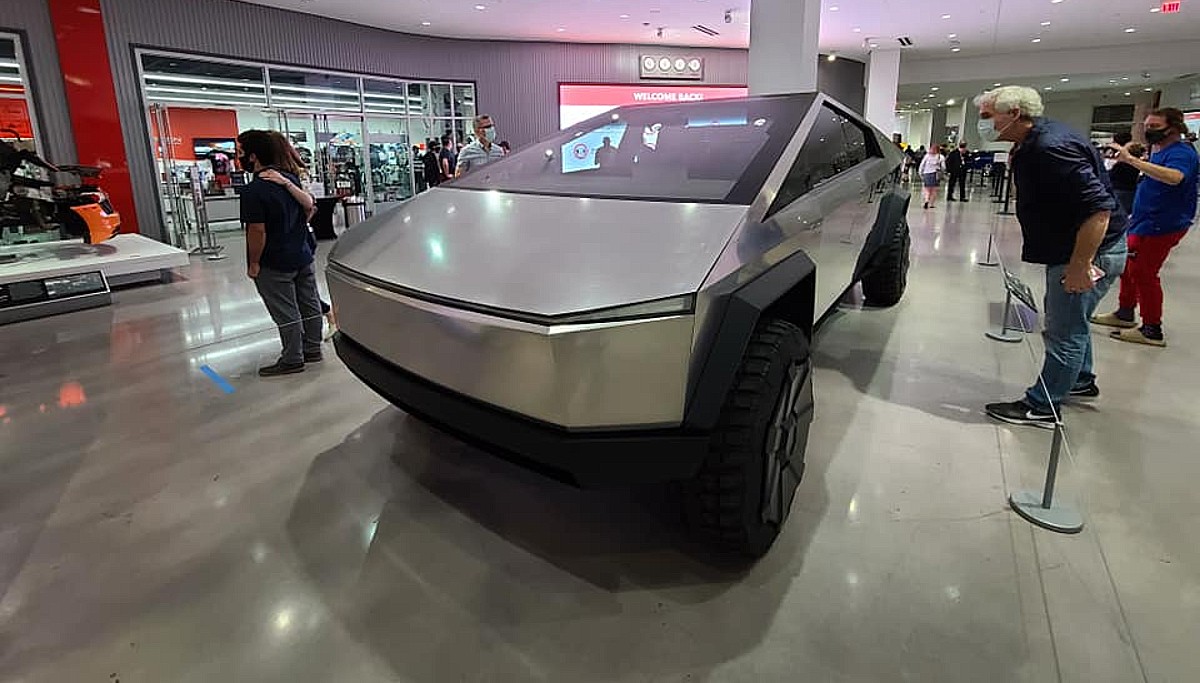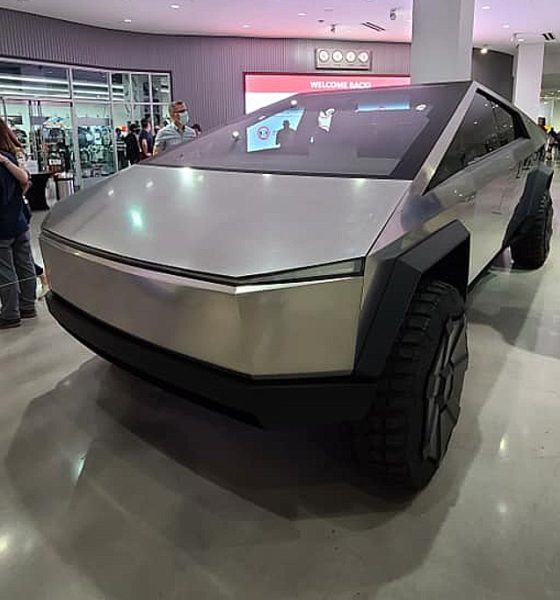

Investor's Corner
Tesla’s Elon Musk opens up about Giga-Texas selection, possible 3rd US factory
Tesla CEO Elon Musk opened up about his company’s decision to bring its next North American production facility to Austin, Texas, and also shared his thoughts on a third United States factory within the next few years.
Musk joined Jason Stein for the second part of the Automotive News podcast, where the CEO detailed the strong interest of his employees for an Austin Cybertruck factory over other Texas cities.
Before deciding on where Tesla would begin building its second U.S. production facility, Musk says that he had a sitdown with key members of the electric automaker’s team. Some members of Tesla’s management would have to move to Texas to oversee some of the company’s actions in the Lone Star State, and Musk wanted to make sure that those individuals were comfortable with where they would be moving to.
“When talking to key members of the team that would need to move to Austin from California in order to get the factory going, Austin was their top pick to be totally frank,” Musk said. “That was a big factor in choosing Texas and Austin. Specifically Austin. I guess a lot of people from California if you ask them what’s the one place you’d move outside of California, it’s Austin.”
Tesla was conflicted between some Texas cities, like Dallas, as well as Tulsa, Oklahoma, for the home of its next Gigafactory production facility. However, company executives were undoubtedly more prone to Austin, which could have ultimately led to the company choosing that location.
“That was a big factor, you know? Where do you want to spend time? And, where would you potentially move? Austin was just the number one choice,” Musk explained.
Musk personally announced the company’s intentions to build a new production facility in Austin during the company’s Q2 Earnings Call on July 22.
Although Tesla cannot directly sell to consumers in Texas due to current laws, it is the company’s second-biggest market, Musk said. Its centrally-located position in the U.S. was another reason Tesla chose to extend its hand to Austin. Not only would it make more sense economically to place a factory closer to the East Coast, but it also takes some stress away from the environment during the logistics process.
Musk indicated that transporting cars to East Coast-located buyers was not economical, nor was it good for the environment. These two factors, along with an increase in demand, could segway Tesla straight into a third U.S. factory.
The demand for Tesla’s electric vehicles continues to skyrocket, and there is the possibility that the company could end up building a third plant that could be located in the U.S. to take care of those needs.
Stein asked, “Do you think there could be additional areas of the U.S. that you’d consider for manufacturing beyond this?”
“I think at some point, there will be a third Gigafactory [in the U.S.],” Musk explained. “I’d imagine, you know, closer up North, Northeast, most likely.”
The Tesla CEO also indicated that the next facility could come in “four-ish” years as a rough estimate.
Tesla’s ultimate decision to create a manufacturing facility in Austin will cut down on the logistics timeline the company maintains for delivering its vehicles. East Coast customers will undoubtedly experience more efficient delivery timelines as the company will not be transporting cars from its Fremont factory in Northern California to various states in the Eastern half of the country.
Giga, Texas will produce the Model Y, Model 3, Semi, and Cybertruck.
The second part of Musk’s interview with Automotive News is available in its entirety here.

Investor's Corner
Tesla stock closes at all-time high on heels of Robotaxi progress

Tesla stock (NASDAQ: TSLA) closed at an all-time high on Tuesday, jumping over 3 percent during the day and finishing at $489.88.
The price beats the previous record close, which was $479.86.
Shares have had a crazy year, dipping more than 40 percent from the start of the year. The stock then started to recover once again around late April, when its price started to climb back up from the low $200 level.
This week, Tesla started to climb toward its highest levels ever, as it was revealed on Sunday that the company was testing driverless Robotaxis in Austin. The spike in value pushed the company’s valuation to $1.63 trillion.
Tesla Robotaxi goes driverless as Musk confirms Safety Monitor removal testing
It is the seventh-most valuable company on the market currently, trailing Nvidia, Apple, Alphabet (Google), Microsoft, Amazon, and Meta.
Shares closed up $14.57 today, up over 3 percent.
The stock has gone through a lot this year, as previously mentioned. Shares tumbled in Q1 due to CEO Elon Musk’s involvement with the Department of Government Efficiency (DOGE), which pulled his attention away from his companies and left a major overhang on their valuations.
However, things started to rebound halfway through the year, and as the government started to phase out the $7,500 tax credit, demand spiked as consumers tried to take advantage of it.
Q3 deliveries were the highest in company history, and Tesla responded to the loss of the tax credit with the launch of the Model 3 and Model Y Standard.
Additionally, analysts have announced high expectations this week for the company on Wall Street as Robotaxi continues to be the focus. With autonomy within Tesla’s sights, things are moving in the direction of Robotaxi being a major catalyst for growth on the Street in the coming year.
Elon Musk
Tesla needs to come through on this one Robotaxi metric, analyst says
“We think the key focus from here will be how fast Tesla can scale driverless operations (including if Tesla’s approach to software/hardware allows it to scale significantly faster than competitors, as the company has argued), and on profitability.”

Tesla needs to come through on this one Robotaxi metric, Mark Delaney of Goldman Sachs says.
Tesla is in the process of rolling out its Robotaxi platform to areas outside of Austin and the California Bay Area. It has plans to launch in five additional cities, including Houston, Dallas, Miami, Las Vegas, and Phoenix.
However, the company’s expansion is not what the focus needs to be, according to Delaney. It’s the speed of deployment.
The analyst said:
“We think the key focus from here will be how fast Tesla can scale driverless operations (including if Tesla’s approach to software/hardware allows it to scale significantly faster than competitors, as the company has argued), and on profitability.”
Profitability will come as the Robotaxi fleet expands. Making that money will be dependent on when Tesla can initiate rides in more areas, giving more customers access to the program.
There are some additional things that the company needs to make happen ahead of the major Robotaxi expansion, one of those things is launching driverless rides in Austin, the first city in which it launched the program.
This week, Tesla started testing driverless Robotaxi rides in Austin, as two different Model Y units were spotted with no occupants, a huge step in the company’s plans for the ride-sharing platform.
Tesla Robotaxi goes driverless as Musk confirms Safety Monitor removal testing
CEO Elon Musk has been hoping to remove Safety Monitors from Robotaxis in Austin for several months, first mentioning the plan to have them out by the end of 2025 in September. He confirmed on Sunday that Tesla had officially removed vehicle occupants and started testing truly unsupervised rides.
Although Safety Monitors in Austin have been sitting in the passenger’s seat, they have still had the ability to override things in case of an emergency. After all, the ultimate goal was safety and avoiding any accidents or injuries.
Goldman Sachs reiterated its ‘Neutral’ rating and its $400 price target. Delaney said, “Tesla is making progress with its autonomous technology,” and recent developments make it evident that this is true.
Investor's Corner
Tesla gets bold Robotaxi prediction from Wall Street firm
Last week, Andrew Percoco took over Tesla analysis for Morgan Stanley from Adam Jonas, who covered the stock for years. Percoco seems to be less optimistic and bullish on Tesla shares, while still being fair and balanced in his analysis.

Tesla (NASDAQ: TSLA) received a bold Robotaxi prediction from Morgan Stanley, which anticipates a dramatic increase in the size of the company’s autonomous ride-hailing suite in the coming years.
Last week, Andrew Percoco took over Tesla analysis for Morgan Stanley from Adam Jonas, who covered the stock for years. Percoco seems to be less optimistic and bullish on Tesla shares, while still being fair and balanced in his analysis.
Percoco dug into the Robotaxi fleet and its expansion in the coming years in his latest note, released on Tuesday. The firm expects Tesla to increase the Robotaxi fleet size to 1,000 vehicles in 2026. However, that’s small-scale compared to what they expect from Tesla in a decade.
Tesla expands Robotaxi app access once again, this time on a global scale
By 2035, Morgan Stanley believes there will be one million Robotaxis on the road across multiple cities, a major jump and a considerable fleet size. We assume this means the fleet of vehicles Tesla will operate internally, and not including passenger-owned vehicles that could be added through software updates.
He also listed three specific catalysts that investors should pay attention to, as these will represent the company being on track to achieve its Robotaxi dreams:
- Opening Robotaxi to the public without a Safety Monitor. Timing is unclear, but it appears that Tesla is getting closer by the day.
- Improvement in safety metrics without the Safety Monitor. Tesla’s ability to improve its safety metrics as it scales miles driven without the Safety Monitor is imperative as it looks to scale in new states and cities in 2026.
- Cybercab start of production, targeted for April 2026. Tesla’s Cybercab is a purpose-built vehicle (no steering wheel or pedals, only two seats) that is expected to be produced through its state-of-the-art unboxed manufacturing process, offering further cost reductions and thus accelerating adoption over time.
Robotaxi stands to be one of Tesla’s most significant revenue contributors, especially as the company plans to continue expanding its ride-hailing service across the world in the coming years.
Its current deployment strategy is controlled and conservative to avoid any drastic and potentially program-ruining incidents.
So far, the program, which is active in Austin and the California Bay Area, has been widely successful.








